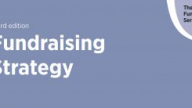The first step in building your fundraising strategy
Richard Sved shares his top tips for getting started on a fundraising strategy.
“Where are we now? Where are we now?” – David Bowie
Having already co-written a 200-page book on Fundraising Strategy for DSC, being asked to write a 500-word blog as a short guide to building a fundraising strategy is quite a challenge. But here goes!
I’d always recommend starting by breaking your strategic thinking on fundraising (and indeed your organisation as a whole) into three parts: where you are you now, where you want to get to, and how. This blog focuses on the first of these: understanding where you and your organisation’s fundraising are now.
In fundraising terms, this is essentially about doing an audit of your organisation’s fundraising efforts. This is about understanding both the internal and external environments in which you do your fundraising, and the classic fundraising SWOT (Strengths, Weaknesses, Opportunities, Threats).
What is the relationship between your fundraising strategy and your organisational strategy? Is there a ‘two way conversation’ between the two of them so that they can feed off each other? Don’t worry if the answer is currently “no” – but this should be where you want to get to, if not! If your organisation doesn’t have an organisational strategy (yet, because it really should), then I would instead think about the organisation’s vision, mission or objectives.
Externally, I would suggest thinking about the environment in which your charity sits by doing some STEEPLE analysis. This acrostic is a neat way of remembering the various factors against which you can assess your organisation’s place in the external environment: social, technological, economic, environmental, political, legal, and ethical.
And as for the fundraising itself, still thinking externally: who are your competitors, and what are they doing? What are their trends in results in fundraising over a longer period? What trends are there in the sector? What strategies and tactics led to those results?
And back to thinking internally: Who is your audience? Why do they support you, or why might they support you? In what ways can you attract them? Where can you go to find them (geographically or digitally, for example)? When might they consider supporting you? And how might they support you?
The first stage of an internal audit would most commonly focus on analysing your fundraising results. Think in the first instance about what metrics you will use to analyse your organisation’s current, recent and historic fundraising. The key metrics are most likely to be income and expenditure, of course, but you might also like to consider others. These could include a number of event participants, people who’ve expressed interest in legacy giving, donor attrition, levels of satisfaction among donors, and more besides. And if you don’t have that data internally, or if you’re considering something new, do you have any results from a related area that might be relevant?
You might like to benchmark your results, either internally where you might track your metrics over time) or externally (where you compare your results with peers. You could compare Return On Investment, for example, or donor retention. Don’t let good benchmarking and data analysis come at the expense of being creative and testing some new things, though.
And most importantly, when looking at your fundraising results, think about why they are what they are. What do you need in terms of team and culture, going forward? This will help you as you set your strategy, in order to set targets that are achievable.
Finally, for this blog, think about your various fundraising products and income streams. Where are they in a life cycle? Are they mature yet, or still growing? Which areas have growth potential? Which areas might be in decline? Where are your current risks?
All of the above should help you to think about where you are now and should begin to help you work out where you want to get to, and how. The next two questions will be the subject of future blogs, or you might want to get a more detailed picture from the book Claire Routley and I co-wrote! You can learn more about it by clicking here.
Until next time, happy fundraising. You’re doing amazing things. May you change the world with your success!



